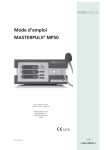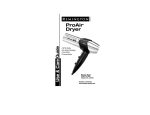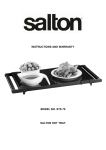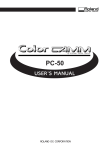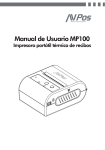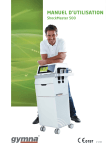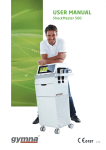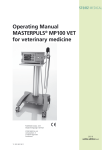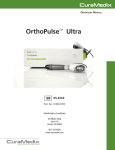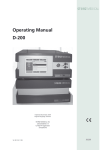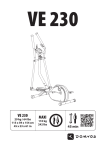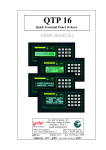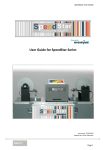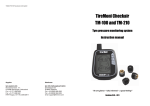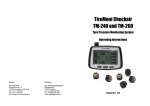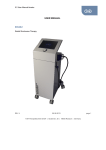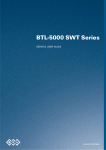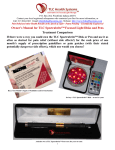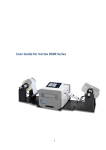Download 1.3.3 Optional ENERGY compressor for
Transcript
Operating Manual MASTERPULS MP100 TABLE OF CONTENTS Inhalt 1 1.1 1.1.1 1.1.2 1.1.3 1.2 1.3 1.3.1 1.3.2 1.3.3 General Information Introduction Indications Contraindications Side effects Key Description of controls and functional elements MASTERPULS MP 100 Applicator Optional ENERGY compressor for MASTERPULS MP100 (Optional) 5 5 6 7 7 8 9 9 11 13 2 2.1 2.2 2.3 2.3.1 2.3.2 2.3.3 2.3.4 2.3.5 2.3.6 14 14 14 15 15 16 17 19 19 2.3.7 Installation Unpacking Scope of supply Installation Applicator holder installation Mains voltage selection Connecting the compressed air supply Connecting power supply cables between systems and socket Applicator connection Optional foot switch connection (Foot switch KARL STORZ 20010230) Optional potential equalization 20 20 3 3.1 3.2 3.3 3.4 3.5 Operation General warnings and safety information Start up Functional checks Standard settings Treatment 21 21 23 25 25 26 4 4.1.1 4.1.2 4.1.3 4.1.4 4.1.2.1 4.1.2.2 4.1.4.2 4.2 4.3 4.4 4.4 Cleaning, maintenance, overhaul Control unit Applicator Optional foot switch (KARL STORZ 20010230) Optional ENERGY compressor Emptying the condensate collector Replacing the filter element ENERGY compressor mains fuse replacement Maintenance Disposal Repair Applicator sealing ring replacement 27 27 27 28 28 28 29 33 34 34 34 35 11 301 02 0205 3 TABLE OF CONTENTS 4 4.5 4.6 4.6.1 4.6.2 Replacement of shock absorber in applicator Overhaul Content of the overhaul kit Overhaul instructions 36 36 37 37 5 5.1 Trouble-shooting Trouble-shooting 41 41 6 6.1.1 6.1.2 6.1.3 6.1.4 Accessories and spare parts MASTERPULS MP100 Optional ENERGY compressor Accessories Documentation 42 42 43 43 43 7 7.1 7.2 7.2.1 7.3 7.2.2 7.4 Technichal specifications MASTERPULS MP100 Compressor Energy compressor Conformity with standards Sil.Air 50 TDC compressor Conformity with directives 44 44 45 45 46 46 47 8 8.1 8.2 Warranty and Service Warranty Service 47 47 47 11 301 02 0205 CHAPTER 1 - GENERAL INFORMATION 1 General Information 1.1 Introduction This manual contains warnings, safety instructions and specific operating instructions in accordance with liability regulations. CAUTION Complete or partial failure to observe the instructions, information or procedures preceded by the term „CAUTION“ may cause injury or fatal accidents. ATTENTION Complete or partial failure to observe the instructions, information or procedures preceded by the term „ATTENTION“ may cause equipment damage. NOTE Additional information concerning specific features or operating instructions is preceded by the term „NOTE“. CAUTION Before you start using the MASTERPULS MP100 for the first time, please make sure you have read and understood all information provided in this operating manual. Please refer to the separate operating manual prior to any use or overhaul of the Sil.Air 50 TDC compressor. Familiarity with the information and instructions contained in this manual is an essential requirement to ensure efficient and optimal use of the system, to avoid dangers to persons and to the equipment and to obtain good treatment results. Thorough knowledge of the information included in this manual will also enable you to react promptly and effectively in case of malfunctions and failures. 11 301 02 0205 5 CHAPTER 1 - GENERAL INFORMATION The MASTERPULS MP100 is a compressed air operated ballistic shock wave generator featuring high-precision ballistic components in its applicator for shock wave generation. The motion and weight of the projectile accelerated by compressed air produce kinetic energy that is converted into sound energy when the projectile strikes an unmoved surface (shock transmitter). This acoustic pulse is transmitted to the target tissue by means of an acoustic impedance adapter (shock wave coupling cushion) or gel. NOTE Medical devices operating on the basis of the above principle are generally referred to as extracorporeal shock wave systems in modern medical literature. 1.1.1 Indications The MASTERPULS MP100 is designed for extracorporeal shock wave therapy. Indications include: 6 - calcaneal spur / plantar fascitis - muscle trigger points A sound knowledge of trigger point therapy and trigger point shock wave therapy (TrST) is required for therapeutic application of the MASTERPULS MP100 in the field of trigger point shock wave therapy. shoulder pain with or without calcifications achillodynia trochanteric bursitis / proximal iliotibial band friction syndrome radial/ulnar humeral epicondylitis patellar tendinopathy tibial edge syndrome insertion tendonitis in general acupuncture Qualified training in acupuncture and acupuncture shock wave therapy (AkuST) is required for therapeutic application of the MASTERPULS MP100 in the field of acupuncture. 11 301 02 0205 CHAPTER 1 - GENERAL INFORMATION 1.1.2 Contraindications Treatment with the STORZ MEDICAL MASTERPULS MP100 is not permitted in the following cases: - coagulation disorders (haemophilia) use of anticoagulants, especially Marcumar thrombosis tumour diseases, carcinoma patients pregnancy polyneuropathy in case of diabetes mellitus acute inflammations / pus focus in the target area children in growth cortisone therapy up to 6 weeks before first treatment CAUTION Shock waves must not be applied to target areas located above air filled tissue (lungs), nor to any regions near large nerves, vessels, the spinal column or head. 1.1.3 Side effects Treatment with the MASTERPULS MP100 may cause the following side effects: - swelling, reddening, haematomas - petechiae pain skin lesions after previous cortisone therapy These side effects generally abate after 5 to 10 days. 11 301 02 0205 7 CHAPTER 1 - GENERAL INFORMATION 1.2 Key Operating manual to be observed! Applicator connector Foot switch connector (optional) Potential equalization ~ AC I/0 ON/OFF switch Application pressure in bar (pressure gauge reading) Analog setting of application pressure (control knob) M Mode button for mode selection: single shock / continuous shock Single shock Continuous shocks at 5 Hz frequency Continuous shocks ar 15 Hz frequency / blinking Continuous shocks at 10 Hz frequency ∑ Applied shocks in total (digital display) Fuse Type B applied part Air: 5-7bar 8 Compressed air connector 11 301 02 0205 CHAPTER 1 - GENERAL INFORMATION 1.3 Description of controls and functional elements 1.3.1 MASTERPULS MP 100 1 2 3 4 5 6 10 Abb. 1 - 1 9 8 7 Front view of MASTERPULS MP100 1 2 3 4 5 Pressure gauge indicating selected energy level (application pressure) Selected shock frequency symbol: single shock Selected shock frequency symbol: 5 Hz, 10 Hz, 15 Hz Treatment shock counter (resettable) Shock counter reset button 6 7 8 Foot switch connector Applicator connector Mode button, shock frequency selector button 9 Energy level control knob (application pressure) 10 Mains switch 11 301 02 0205 9 CHAPTER 1 - GENERAL INFORMATION 1 2 3 5 Fig. 1 – 2 1 2 3 4 5 10 4 Rear view of MASTERPULS MP100 Operation shock counter (not resettable) Mains connector Fuse holder Potential equalization connector Compressed air connector (input) 11 301 02 0205 CHAPTER 1 - GENERAL INFORMATION 1.3.2 Applicator 2 1 3 4 5 6 Fig. 1 – 3 1 2 3 4 5 6 Applicator with connecting cable Shock transmitter Shock transmitter screw cap Trigger button Locking button Shock absorber Applicator connecting cable Fig. 1 – 4 11 301 02 0205 Shock transmitter with sealing rings 11 CHAPTER 1 - GENERAL INFORMATION Depending on the therapy to be performed, the applicator can be equipped with one of the following five shock transmitters: - ESWT shock transmitter (Fig. 1 – 5/1) for ESWT therapy: Ø 15 mm TrST shock transmitter (Fig. 1 – 5/2) for trigger point therapy: Ø 10 mm AkuST shock transmitter (Fig. 1 – 5/3) for therapeutic shock wave application in acupuncture: Ø 6 mm (Fig. 1 - 5/3) Ø 6mm 2 1 Fig. 1 – 5 - 3 ESWT, TrST and AkuST shock transmitters Optional: Focus shock transmitter Optional: D-Actor shock transmitter NOTE Always use an acoustic impedance adapter (shock wave coupling cushion) (Fig. 1 – 6/1) in order to ensure perfect hygiene during patient treatment. 1 Fig. 1 – 6 12 Shock transmitter with acoustic impedance adapter 11 301 02 0205 CHAPTER 1 - GENERAL INFORMATION 1.3.3 Optional ENERGY compressor for MASTERPULS MP100 (Optional) The ENERGY compressor provides the compressed air supply for the MASTERPULS MP100 and can be ordered as an option. 1 Fig. 1 – 7 1 Front view of ENERGY compressor Mains switch 1 2 3 4 Fig. 1 – 8 1 2 3 4 5 6 5 6 Rear view of ENERGY compressor Compressed air connector (output) Fuse holder Mains connector Connector for mains power link cable (mains output for MASTERPULS MP100 control system) Potential equalization connector Condensate collector 11 301 02 0205 13 CHAPTER 2 - INSTALLATION 2 Installation 2.1 Unpacking • Remove the equipment and accessories from the packaging container. Proceed with extreme caution. • Check that all items are included in the packaging container and that they are not damaged. • Contact your supplier or the manufacturer immediately if any items are missing or damaged. Retain the original packaging, if possible. It may prove useful for any later equipment transport. 2.2 Scope of supply The standard scope of supply of the STORZ MEDICAL MASTERPULS MP100 includes the following items: - Î6 14 MASTERPULS MP100 (control system) applicator with accessories (2 shock transmitters, complete applicator holder, acoustic impedance adapter) mains cable mains power link cable compressed air tube overhaul kit for applicator overhaul 850 ml gel user manual (operating manual, system logbook and training records) Please refer to Section 6 for information on ACCESSORIES AND SPARE PARTS. 11 301 02 0205 CHAPTER 2 - INSTALLATION 2.3 Installation 2.3.1 Applicator holder installation The applicator can be fitted to the right or left side of the system as desired by the system user. Owing to the specific shape of the applicator holder and the location of the bores provided on the side panels of the system, the applicator holder can be mounted either parallel to the system front (Fig. 2 – 1/1) or in an inclined position. • If you wish to mount the applicator holder parallel to the system front, fix the holder by tightening both screws (Fig. 2 – 1/). Fig. 2 – 1 • If you wish to mount the applicator holder in such a way that it is inclined towards the front, then use only one screw (Fig. 2 – 2) to fix the holder, making sure that the bevelled edge of the holder ends at the front strip of the side panel. Fig. 2 - 2 • Mounting position parallel to system front Inclined mounting position Regardless of the installation position you choose, make sure that the smaller holder ring points downwards. 11 301 02 0205 15 CHAPTER 2 - INSTALLATION 2.3.2 Mains voltage selection ATTENTION Check that the mains voltage set on the MASTERPULS MP100 matches the local mains voltage to avoid system damage. • Remove the mains fuse holder (Fig. 2 – 3/1) from the rear panel of the MASTERPULS MP100 and take off the voltage selector (Fig. 2 – 3/3) 1 2 3 Fig. 2 – 3 Mains fuse holder NOTE The MASTERPULS MP100 is set to a local mains voltage of 230 VAC when delivered. 16 • Make sure to use only fuses that meet the requirements specified in Table 2 – 1. • Replace the fuses, if necessary. 11 301 02 0205 CHAPTER 2 - INSTALLATION Mains voltage Fuse rating 230 / 240 VAC 2 x T 0,2 A L 100 / 120 VAC 2 x T 0,5 A L Table 2 – 1 Fuse rating 120 100 Insert the voltage selector into the mains fuse holder in such a way that the mains voltage visible through the glass window on the outside of the fuse holder (Fig. 2 – 3/2) matches the local mains voltage. 240 230 • ATTENTION Check that the fuses installed are rated for the selected voltage! The mains voltage of the optional compressor cannot be changed. The compressor is available in three different versions (110 V, 115 V, 220 - 240 V). 2.3.3 Connecting the compressed air supply ATTENTION The compressed air input pressure must be 5.0 - 7.0 bar. If compressors other than the STORZ MEDICAL ENERGY compressor are used, this pressure must be checked on the compressed air supply system. If the pressure exceeds 7.0 bar the system‘s overpressure protection will be tripped. The compressed air must be dry, oil-free and filtered to ≤ 5 micron. Never use CO2 gas for compressed air supply. 11 301 02 0205 17 CHAPTER 2 - INSTALLATION ATTENTION If compressed air is supplied through a wall outlet, use a pressure reducer (max. 7 bar), if necessary. • Place the optional ENERGY compressor onto a solid and stable surface. The MASTERPULS MP100 and the ENERGY compressor may be positioned on top or beside each other. • Connect the compressed air tube to the compressed air connectors provided on the compressor (Fig. 2 – 5/1) and MASTERPULS MP100 (Fig. 2 – 4/5). 2 3 4 5 Fig. 2 – 4 Connectors on the MASTERPULS MP100 1 2 3 4 Fig. 2 - 5 18 Connectors on the ENERGY compressor 11 301 02 0205 CHAPTER 2 - INSTALLATION 2.3.4 Connecting power supply cables between systems and socket • Connect the mains power link cable to the mains output connector (Fig. 2 – 5/3) provided on the ENERGY compressor. • Connect the other end of the mains power link cable to the mains connector of the MASTERPULS MP100 (Fig. 2 – 4/2). • Connect one end of the mains cable to the mains connector (Fig. 2 – 5/2) of the compressor and the other end to the socket. • If the MASTERPULS MP100 is used without the optional ENERGY compressor, the mains cable is directly connected to the MASTERPULS MP100 and to the socket. 2.3.5 • Applicator connection Connect the applicator cable to the applicator connector (Fig. 2 – 6/2) provided on the MASTERPULS MP100. Make sure that the red spots on the cable connector match the red spots on the applicator connector. 1 Fig. 2 – 6 11 301 02 0205 Applicator connector 2 19 CHAPTER 2 - INSTALLATION 2.3.6 • Optional foot switch connection (Foot switch KARL STORZ 20010230) Connect the foot switch cable (special accessories) to the foot switch connector (Fig. 2 – 6/1) provided on the MASTERPULS MP100. NOTE The optional foot switch (KARL STORZ 20010230) complies with IPX8 rating according to IEC529 (degree of protection against water). 2.3.7 Optional potential equalization The MASTERPULS MP100 and the ENERGY compressor both feature a potential equalization connector (see Fig. 2 – 4/4 and Fig. 2 – 5/4). Where necessary, connections for potential equalization must be made by suitably qualified personnel. 20 11 301 02 0205 CHAPTER 3 - OPERATION 3 Operation 3.1 General warnings and safety information CAUTION The MASTERPULS MP100 must only be used by suitably qualified and trained medical personnel. The MASTERPULS MP100 must only be used for applications approved by STORZ MEDICAL AG! To avoid safety hazards, use of the system for applications other than those specified in Section 1.1.1 INDICATIONS is not allowed! Unplug the mains cable from the system and compressor before carrying out cleaning and maintenance work! Î 1.1.1 Do not use the MASTERPULS or the ENERGY compressor in potentially explosive environments, i.e. in the presence of a flammable anaesthetic mixture with air or with oxigen or nitrous oxide. The optional KARL STORZ foot switch must not be used in potentially explosive atmospheres according to classification AP as per IEC 60601. Unplug the applicator cable from the control system before carrying out cleaning and maintenance work. Do not reconnect the applicator until it has been completely reassembled! Do not try to open the system! Risk of electric shocks! Risk of transmission of microorganisms! Disinfect the applicator after each use! Refer to chapter 4 CLEANING for details. Î4 ATTENTION Check that the installation surfaces have sufficient carrying capacity to avoid equipment damage! The system must only be connected to properly earthed and correctly installed shockproof sockets! Check that the system is in perfect working order before each use. Never cover the system when in use! Make absolutely sure that no liquid can seep into the system housing or applicator. 11 301 02 0205 21 CHAPTER 3 - OPERATION ATTENTION Equipment damage caused by failure to use the system in accordance with its intended use or by operator errors is not covered by the warranty. The MASTERPULS MP100 must only be used with accessories that have been approved by the system manufacturer. To prevent safety hazards, unauthorized system modifications are not allowed and will void the CE mark approval and warranty. Disposal of the system and its components must be carried out in accordance with national waste disposal regulations. NOTE The MASTERPULS MP100 as well as the ENERGY compressor meets the requirements of the applicable electromagnetic compatibility (EMC) standards EN 60601-1-2. These limits are designed to provide reasonable protection against harmful interference in a typical medical installation. The equipment generates, uses and can radiate radio frequency energy and, if not installed and used in accordance with these instructions, may cause harmful interference to other devices in the vicinity. However, there is no guarantee that interference will not occur in a particular installation. If this equipment does cause harmful interference with other devices, which can be determined by turning the equipment off and on, the user is encouraged to try to correct the interference by one or more of the following measures: • Reorient or relocate the receiving device • Increase the separation between the equipment • Connect the equipment into an outlet on a circuit different from that to which the other device(s) is connected • Consult the manufacturer of field service technician for help. 22 11 301 02 0205 CHAPTER 3 - OPERATION 3.2 Start up • Switch on the compressor followed by the control system. • Use the control knob (Fig. 3 – 1/5) to select an initial value for the shock application pressure (min. 1.0 bar). The selected value is indicated on the pressure gauge (Fig. 3 – 1/1). 1 2 3 5 Fig. 3 – 1 4 Application pressure selection on control system The maximum application pressure is limited to 4 bar. To ensure correct system operation, a minimum 1.0 bar pressure must be selected. • Select the shock frequency by pressing the M (mode) button (Fig. 3 – 1/4). single shock continuous shocks: 5 shocks / sec. continuous shocks: 10 shocks / sec. blinking continuous shocks: 15 shocks / sec., press the mode button for at least 2 sec. • Press the trigger button provided on the applicator (Fig. 3 – 2/2). • A single press of the trigger button will cause one shock to be released. • In order to work in continuous shock mode, press and hold the trigger button or press the locking button (Fig. 3 – 2/1) while at the same time pressing the trigger button. 11 301 02 0205 23 CHAPTER 3 - OPERATION • Unlock the locking button if you wish to disable continuous shock mode. 1 2 Fig. 3 – 2 24 Trigger button and locking button 11 301 02 0205 CHAPTER 3 - OPERATION 3.3 Functional checks Perform the following functional checks after the system has been installed: • Check the control system and applicator for damage. • Start the MASTERPULS MP100. • Set the application pressure to 2.0 bar. • Reset the treatment shock counter on the front of the control system. • Release individual shocks in single shock mode. • Release shocks in continuous shock mode (shock frequency 5 Hz , 10 Hz and 15 Hz). • Check that the triggered shocks are correctly counted on the treatment shock counter on the front of the control system. • Select the maximum 4 bar application pressure. • Release individual shocks in single shock mode. • Release shocks in continuous shock mode (shock frequency 5 Hz , 10 Hz and 15 Hz). • Release shocks by means of the foot switch, if used. 3.4 Standard settings • Before each therapy session, press the reset button (Fig. 3 – 1/3) to reset the treatment shock counter (Fig. 3 – 1/2) provided on the control system. • The number of shocks to be applied for trigger point shock wave therapy (TrST) and acupuncture shock wave therapy (AkuST) differs from ESWT treatment. Such therapies must only be performed by suitably qualified and trained personnel. • A total of about 2000 shocks must generally be applied per therapy session. Please refer to the MASTERPULS MP100 application brochure for details. • Start the therapy at a pressure of 2 bar and a frequency of 5 Hz. 11 301 02 0205 25 CHAPTER 3 - OPERATION 3.5 Treatment • Perform treatment as described in the MASTERPULS MP100 application brochure. • Apply a sufficient amount of coupling gel to the patient’s skin in the coupling area and to the shock transmitter. • When using the acoustic impedance adapter, generously apply coupling gel to both sides of the adapter. Bear in mind that the acoustic impedance adapter cannot be used if treatment is performed with the TrST shock transmitter. • Fit the acoustic impedance adapter into the mounting groove (Fig. 3 – 3/1) provided on the shock transmitter screw cap. 1 Fig. 3 – 3 Mounting groove for acoustic impedance adapter CAUTION The MASTERPULS MP100 must only be used for applications approved by STORZ MEDICAL AG! Î 1.1.1 26 To avoid safety hazards, use of the system for applications other than those specified in Section 1.1.1 (INDICATIONS) is not allowed! 11 301 02 0205 CHAPTER 4 - CLEANING, MAINTENANCE, OVERHAUL 4 Cleaning, maintenance, overhaul 4.1 Cleaning Regular cleaning of the system ensures perfect hygiene and operation of the MASTERPULS MP100. CAUTION Prior to performing any cleaning unplug the mains cable. 4.1.1 • Control unit Clean the exterior of the unit with a moist cloth. Use soap water or a mild cleaning agent. ATTENTION Under all circumstances the unit tubes must be protected from intruding fluids of all kinds. 4.1.2 Applicator The applicator must be thoroughly cleaned and disinfected after each therapy session. • Remove the acoustic impedance adapter, if necessary. • Clean the applicator with soap water to remove the ultrasound coupling gel. • We advise to open the shock transmitter screw cap and to clean the shock transmitter as well as the screw cap separately. • Disinfect the applicator with a surface disinfectant. • The acoustic impedance adapter is not suitable for reuse. 11 301 02 0205 27 CHAPTER 4 - CLEANING, MAINTENANCE, OVERHAUL 4.1.3 • Optional foot switch (KARL STORZ 20010230) Clean the foot switch with soap water or a mild cleaning agent. NOTE The foot switch is classified as IPX8 (degree of protection against water) according to IEC529. 4.1.4 • Optional ENERGY compressor Clean the exterior of the compressor with a wet cloth. Use soap water or a mild cleaning agent. ATTENTION Under all circumstances the unit tubes must be protected from intruding fluids of all kinds. 4.1.2.1 Emptying the condensate collector The condensate collector on the rear side of the ENERGY compressor should be emptied when three quarters full or earlier. • Remove the condensate collector (Fig. 4 – 1/1) from the holder on the rear side of the compressor. • Empty the collector and place it back into the holder. 1 Fig. 4 – 1 28 Condensate collector 11 301 02 0205 CHAPTER 4 - CLEANING, MAINTENANCE, OVERHAUL 4.1.2.2 Replacing the filter element CAUTION The pump head of the ENERGY compressor becomes very hot during operation. Let the compressor cool down before replacing the filter element. Contents of the filter element replacement kit (Art.-No. 14464): 1 filter element 1 allen key 1 air input filter The filter element and the air input filter of the ENERGY compressor should be replaced in case of performance loss (drop of pressure during the release of shocks. Proceed as follows: • Switch off the compressor by setting the mains switch provided on the front panel to OFF. Unplug the mains cable. • Vent the compressor system before removing the compressed air tube. To do so, press the rapid action safety coupling (Fig. 4 – 2/1) provided for the compressed air tube towards the rear panel of the compressor until it snaps into place. 1 Æ Fig. 4 – 2 System venting • After having vented the compressor, pull the rapid action safety coupling back into its normal position. • Remove the compressed air tube from the rapid action safety coupling. • Turn the compressor upside down in order to be able to open the bottom panel. • Remove the 4 hexagon socket screws (Fig. 4 – 3/1 to Fig. 4 – 3/4) from the bottom panel by means of the supplied allen key. 11 301 02 0205 29 CHAPTER 4 - CLEANING, MAINTENANCE, OVERHAUL 1 4 3 Fig 4 – 3 • 2 Opening the bottom panel Remove the condensate discharge tube (Fig. 4 – 4/1) from the L-type screwed tube joint of the metal container. While doing so, press the metal clamping ring (Fig. 4 – 4/2) backwards. 1 2 3 4 5 Fig. 4 – 4 30 Opening the metal container • Unscrew the metal container (Fig. 4 – 4/4) from its mounting, eventually using a pair of pliers. For this purspose, please seize the nut of the L-type screwed tube joint (Fig. 4 – 4/3). • The pressure filter metal container (Fig. 4 – 5/1) is equipped with a float valve (Fig. 4 – 5/2) and sealing ring (Fig. 4 – 5/3). Make sure that during removal of the metal container the float valve and sealing ring remain attached to the container and do not fall into the compressor. 11 301 02 0205 CHAPTER 4 - CLEANING, MAINTENANCE, OVERHAUL 1 2 3 Fig. 4 – 5 • Metal container with float valve and sealing ring Screw off the white filter element (Fig. 4 – 6/1) with the black air current control ring (Fig. 4 - 6/2). 1 2 Fig. 4 – 6 • Removal of filterelements Screw the air current control ring (Fig. 4 – 7/2) off the white filter element. Dispose of the filter element (Fig 4 – 7/1). The air current control ring will be reused. 1 2 Fig. 4 - 7 White filter element with current control ring • Take the new white filter element included in the filter element replacement kit and screw it into the air control ring . • Install the filter element in the bottom of the pressure filter metal container (Fig. 4 – 6/3) in the compressor. 11 301 02 0205 31 CHAPTER 4 - CLEANING, MAINTENANCE, OVERHAUL • If the float valve (Fig. 4 – 8/2) falls out of the new pressure filter metal container, move it back into its original position by means of tweezers so that the sealing pin (Fig. 4 – 8/1) is located precisely in the opening provided inside the metal container. 1 Fig. 4 - 8 2 Float valve with sealing pin ATTENTION If the sealing pin is bent or if it is positioned inaccurately, the float valve installed in the pressure filter metal container may come loose and may not properly seal off any more! 32 • Insert the new sealing ring provided for the pressure filter metal container (Fig. 4 – 5/3) into the cavity on the bottom edge of the container. Check that the sealing ring fits well. If necessary, moisten the sealing ring to make sure it cannot fall out. • Screw the pressure filter metal container to the holder. Tighten it until hand-tight. • Push the condensate discharge tube into the L-type screwed tube joint. • Unscrew the used air input filter (Fig. 4 - 4/5), preferable using a pair of pliers, and screw the new air input filter part of the filter element replacement kit on to mounting. • Fasten the bottom panel by means of the 4 screws • Fasten the compressed air tube in the rapid action safety coupling. • Plug in the mains cable. 11 301 02 0205 CHAPTER 4 - CLEANINIG, MAINTENANCE, OVERHAUL 4.1.4.2 ENERGY compressor mains fuse replacement The holder of the mains fuse is located at the rear panel of the compressor (see Fig. 1 - 8/2). • Push the clip of the mains fuse holder (Fig. 4 - 9/1) upwards and take the holder off the housing. 1 Fig. 4 - 9 • Mains fuse holder Pull the old fuses out of the fuse holder (Fig. 4 - 10/1). 1 Fig. 4 - 10 Fuse replacement • Replace the fuses. • Push the fuse holder back in to the opening until engaged. 11 301 02 0205 33 CHAPTER 4 - CLEANING, MAINTENANCE, OVERHAUL 4.2 Maintenance Preventive maintenance is not necessarily required. However, regular maintenance may help to identify possible defects at an early stage and thus increase the safety and service life of the equipment. Maintenance services can be ordered from our regional representatives in your area or directly from STORZ MEDICAL AG. We recommend that functional and safety checks be performed at least once a year. National accident prevention regulations and test and inspection intervals prescribed for medical devices must, of course, be observed. NOTE For further details on content and performance of the safety checks please contact your local dealer. Perform the following tests in order to ensure perfect functioning of the MASTERPULS MP100 and the ENERGY compressor. 1. Leakage current test at chassis < 100 µΑ 2. Earth impedance test (incl. applicator housingl) < 0,2 Ohm (with mains cable) 3. Power consumption test <= rated power For additional information on the overhaul of the Sil.Air 50 TDC compressor please refer to the separate operating manual. 4.3 Disposal When disposing of the present medical device products no special measures have to be observed. Please proceed in accordance with the national regulations. After expiration of their life time, dispose the MASTERPULS MP100 and the ENERGY compressor as electronical scrap. Additional information about the disposal of the Sil.Air 50 TDC compressor please find in the separate operating manual. 4.4 Repair Repair work on defective equipment must only be carried out by personnel suitably authorized by STORZ MEDICAL. Only original STORZ MEDICAL spare parts must be used for this purpose. 34 11 301 02 0205 CHAPTER 4 - CLEANING, MAINTENANCE, OVERHAUL 4.4 Applicator sealing ring replacement NOTE The applicator is equipped with a projectile safety catch device in order to prevent the projectile from exiting in case a shock is released while shock transmitter as well as shock transmitter screw cap are taken off. The safety catch is also activated when the shock transmitter screw cap is not well tightened or the sealing ring between screw cap and shock transmitter is missing, respectively at the shock transmitter endings two sealing rings old/new come together. Once the projectile gets caught by the safety catch, it can be pushed back into the guide tube using reasonable force. If this is repeatedly the case or if it is impossible to release the projectile or if the receptory edge is defectous, the applicator shaft should be replaced . The applicator sealing rings must be replaced after about 250,000 shocks or earlier if leaks are identified on the applicator. Proceed as follows: • Switch off MASTERPULS MP100. • Unplug the applicator cable from the MASTERPULS MP100. • Screw off the shock transmitter screw cap (Fig. 4 – 9/1). • Remove both sealing rings (Fig. 4 – 9/2) and dispose of them. ATTENTION Make sure that no worn sealing rings are in the screw cap or applicator! • Clean shock transmitter and shock transmitter screw cap from remaining oil. • Fit two new sealing rings to the shock transmitter (Fig. 4 – 9/5). • Place the shock transmitter with the new sealing rings into the shock transmitter screw cap. • Firmly screw the shock transmitter screw cap to the applicator. 11 301 02 0205 35 CHAPTER 4 - CLEANING, MAINTENANCE, OVERHAUL 1 2 3 4 5 Fig. 4 – 11 4.5 Sealing ring replacement Replacement of shock absorber in applicator • Remove the old shock absorber (Fig. 4 – 11/4) with a pointed object (screwdriver). • If necessary, remove remaining adhesive elements. • Take the new shock absorber included in the applicator overhaul kit and remove the protective film from the two adhesive strips. • Push the new shock absorber into the cavity on the applicator handle until it snaps into place in the cavity frame. 4.6 Overhaul Shock waves are generated mechanically. Due to the effects of friction, the applicator components are continuously exposed to mechanical stress that will cause minor wear. NOTE The applicator should be overhauled about every 750,000 shocks. Using the overhaul kit that includes all required wear parts, the applicator can be overhauled easily and quickly by the user of the equipment. 36 11 301 02 0205 CHAPTER 4 - CLEANING, MAINTENANCE, OVERHAUL 4.6.1 Content of the overhaul kit Article no. Product description 13692 ESWT shock transmitter (Ø 15 mm) with sealing rings 13280 Projectile 13271 Guide tube 15558 Sealing rings MP100 13677 Fork wrench (jaw size 22) 13479 Box with protective foam sheets 13272 Shock absorber The overhaul kit can be ordered from your dealer quoting order number 13460. 4.6.2 Overhaul instructions NOTE The applicator is equipped with a projectile safety catch device in order to prevent the projectile from exiting in case a shock is released while shock transmitter as well as shock transmitter screw cap are taken off. The safety catch is also activated when the shock transmitter screw cap is not well tightened or the sealing ring between screw cap and shock transmitter is missing, respectively at the shock transmitter endings two sealing rings old/new come together. Once the projectile gets caught by the safety catch, it can be pushed back into the guide tube using reasonable force. If this is repeatedly the case or if it is impossible to release the projectile or if the receptory edge is defectous, the applicator shaft should be replaced . • Switch off the MASTERPULS MP100. • Unplug the applicator cable from the control system. • Place the applicator onto a dry, clean and dust-free surface. 11 301 02 0205 37 CHAPTER 4 - CLEANING, MAINTENANCE, OVERHAUL • Screw off the shock transmitter screw cap (Fig. 4 – 12/1). 2 1 Fig. 4 – 12 • Applicator overhaul Using the supplied fork wrench (Fig. 4 – 13/1), remove the shaft (Fig. 4 – 13/2) from the applicator and pull it out of the applicator handle (Fig. 4 – 13/3). 1 2 3 Fig. 4 – 13 • Shaft removal Remove the guide tube (Fig. 4 – 14/1) from the shaft. 1 Fig. 4 – 14 38 Guide tube removal 11 301 02 0205 CHAPTER 4 - CLEANING, MAINTENANCE, OVERHAUL • A magnet is provided in the applicator handle (Fig. 4 – 13/3) to hold the projectile. To remove the projectile, hold the applicator handle in such a way that its opening points downwards. Slightly knock the handle against the table surface until the projectile falls out. • In case the projectile breaks apart due to overloading, projectile fragments may be located inside the guide tube. • Dispose of the worn guide tube and of all worn shock transmitters and sealing rings. • Clean the shaft and shock transmitter screw cap with alcohol. These parts will be reused. • Make sure to place all cleaned components onto a dry, clean and dustfree surface. • Take the new guide tube, projectile and sealing rings included in the overhaul kit. • Insert the guide tube (Fig. 4 – 15/3) into the opening in the applicator handle (Fig. 4 – 15/1) up to the limit stop. 1 2 Fig. 4 – 15 Guide tube and projectile fitting • 4 Make sure that the guide tube end inserted into the applicator handle is the one featuring two air slots (Fig. 4 – 16/1). 1 Fig. 4 – 16 11 301 02 0205 Guiding tube air slots 39 CHAPTER 4 - CLEANING, MAINTENANCE, OVERHAUL • Insert the new projectile (Fig. 4 - 15/3) into the fitted guide tube. • Screw the shaft into the applicator and tighten it by means of the supplied fork wrench until hand-tight. • New shock transmitters come with new sealing rings. Thus, only replace the sealing ring on the shaft (Fig. 4 - 12/2). ATTENTION Make sure that no worn sealing rings are in the shock transmitter screw cap and on the shaft end! Î 3.3 40 • Replace the shock absorber. • Screw the screw cap with the required shock transmitter back onto the shaft. • Carry out a functional check of the applicator as described in Section 3.3 (FUNCTIONAL CHECKS). 11 301 02 0205 CHAPTER 5 - TROUBLE-SHOOTING 5 Trouble-shooting 5.1 Trouble-shooting CAUTION Unplug the mains cable from the system before you carry out any maintenance work! Fault Possible cause Corrective actions System does not work Power failure Check the power supply. Operating mode LED not lit Defective mains fuse Replace the fuses. Defective mains plug Replace the mains cable. Defective foot switch connecting cable Check the cable and tube connections and replace them, if necessary. No compressed air supply Leaks on applicator cable or cable not properly connected Compressed air tube not connected or not correctly fastened with safety coupling Check the compressor air filter and replace it, if necessary. Clogged compressor air filter No shock wave power output No compressed air supply Check the compressed air supply. Blocked or worn projectile Take applicator apart. Clean the guide tube and projectile. Overhaul the applicator. 11 301 02 0205 41 CHAPTER 6 - ACCESSORIES AND SPARE PARTS 6 Accessories and spare parts 6.1.1 MASTERPULS MP100 Holder, complete 13701 Compressed air tube Compressed air tube for compressor, 1 m long 13463 Compressed air tube for compressor, 3 m long 13447 Compressed air tube for central compressed air supply 13464 Mains cable Mains cable CEE 7 Europe, 4 m long (for control system or SMAG compressor) 13455 IEC coupling, 1 m long (between control system and compressor) 13546 Applicator Ø 15 mm ESWT shock transmitter set 13476 Ø 10 mm TrST shock transmitter set 13457 Ø 6 mm AkuST shock transmitter set 13458 Ø 20 mm D-Actor shock transmitter set 13459 Ø 15 mm Focus shock transmitter set 15100 Applicator shaft 14615 Applicator shaft with notch 15236 Overhaul 42 Applicator overhaul kit 13460 D- actor overhaul kit 13477 11 301 02 0205 CHAPTER 6 - ACCESSORIES AND SPARE PARTS 6.1.2 Optional ENERGY compressor Filter replacement set 14464 Insulating pad 14463 6.1.3 Accessories Gel bottle set (10 bottles) 13473 MASTERPULS MP100 transport suitcase (for control system or Energy compressor or Sil.Air 50 TDC compressor) 13472 MASTERPULS MP100 transport suitcase (for control system or compressor) 11608 MASTERPULS MP100 Trolley 13471 MASTERPULS MP100 Trolley with compressor covering 15149 Foot switch (KARL STORZ 20010230) incl. connection cable 10103 Acoustic impedance adapter 13470 F- Meter 15323 6.1.4 Documentation MASTERPULS MP100 user manual German/English/French 11 301 02 0205 13833 43 CHAPTER 7 - TECHNICAL SPECIFICATIONS 7 Technichal specifications 7.1 MASTERPULS MP100 Operating modes single shock, continuous shock 5 Hz / 10 Hz /15 Hz Energy selection continuously adjustable Max. sound pulse amplitude 14,3 MPa Mains input voltage 100 / 120 / 230 / 240VAC ~ +10% Mains frequency 50 / 60Hz Mains fuse 230 / 240VAC : 2 x T 0,2 A L 100 / 120VAC : 2 x T 0,5 A L Power consumption 40 VA Compressed air supply 5 - 7 bar Compressed air output Max. 4 bar Ambient temperature during operation 10 – 40°C Ambient temperature during storage and transport 0 – 60°C Ambient air pressure 500 hPa - 1060 hPa Air humidity 5 – 95%, non condensing Control system weight 5,2 kg Applicator weight 0,44 kg Housing dimensions (wxhxd) 305 x 155 x 233 mm Classification Class I equipment Protection against ingress of water IPX0 This device complies with the standards EN 60601-1, C22.2 Nr. 601.1-M90 and UL std N0 60601-1. 44 11 301 02 0205 CHAPTER 7 - TECHNICAL SPECIFICATIONS 7.2 Compressor 7.2.1 Energy compressor Art. No. 13465 13466 13476 Mains voltage 220-230 V 115 V 100 V Mains frequency 50 / 60 Hz 60 Hz 50 / 60 Hz Mains fuse T 5 A L (SB) T 6,3 A L (SB) T 6,3 A L (SB) Compressed air output 6 bar Power consumption Power consumption: compressor without additional consumer max. 1225 VA 450 VA 500 VA 500 VA Ambient temperature during operation 10 – 40°C Ambient temperature during storage and transport 0 – 60°C Ambient air pressure 500 hPa - 1060 hPa Air humidity Weight Housing dimensions (wxhxd) Classification Protection against ingress of water 5 – 95%, non-condensing 10,9 kg 10,2 kg 10,2 kg 305 x 155 x 233 mm class I equipment IPX0 This device complies with the standards EN 60601-1, art. No 13466 complies also with C22.2 Nr. 601.1-M 90 and UL std N0 60601-1. 11 301 02 0205 45 CHAPTER 7 - TECHNICAL DATA 7.2.2 Sil.Air 50 TDC compressor Art. No. 14588 Mains voltage 230 V Mains frequency 50 / 60 Hz Mains fuse T 2,4 A L (SB) Compressed air output 8 bar Power consumption 340 VA Ambient temperature during operation 10-30°C Ambient temperature during storage -10 - (+)40°C Ambient air pressure 500 hPa - 1060 hPa Air humidity 5 - 95% , non condensing Weight 22 kg Housing dimensions (wxhxd) 7.3 380 x 330 x 290 mm Conformity with standards EN 60601-1 46 - Type of protection against electric shocks: class 1 - Degree of protection against electric shocks: type B applied part 11 301 02 0205 CHAPTER 8 - WARRANTY AND SERVICE 7.4 Conformity with directives This medical product bears the CE mark in accordance with the Medical Device Directive (MDD) 93/42/EEC. 8 Warranty and Service 8.1 Warranty During the two years‘ warranty period from the date of delivery of the product to the end customer, defects will be remedied at no charge to the customer upon the customer furnishing adequate proof that the defect is due to defects in material or workmanship. Shipping costs and risk of loss of returned products shall be borne by the customer. Please complete the attached warranty card and return it as soon as possible to the address below: STORZ MEDICAL AG Unterseestrasse 47 8280 Kreuzlingen Switzerland ATTENTION Any unauthorized opening, repair or modification of the system will relieve the manufacturer of its liability and responsibility for safe system operation and will automatically void the warranty even before the end of the warranty period. 8.2 Service Should you have any further questions or require additional information, please feel free to call your dealer. 11 301 02 0205 47















































